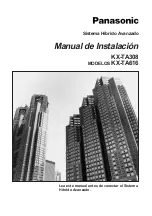
6 - 2 Outside View
①
IC - 300
②
EIC - 300
70.6
57.3
13.3
ȭ
18.9
ȭ
12.8
20.2
75.6
64.3
11.3
ȭ
22.4
20.2
ȭ
12.8
③
KC - 300
④
EKC - 300
ȭ
12.8
(
75.2
)
(
61.9
)
13.3
ȭ
18.9
20.1
20.1
11.3
(
68.9
)
(
80.2
)
ȭ
22.4
ȭ
12.8
Fig. 2
Fig. 3
Fig. 4
Fig. 5
Turn
Transmission Clutch
Tighten
Pin Wrench
Fig. 6 IC - 300 / KC - 300 to the motor
Table. 3
Connected Attachment
IC - 300 / KC - 300
EIC - 300 / EKC - 300
Wrench to use
Pin Wrench (K - 233)
Wrench (20 x 24)
7. CONNECTION OF THE ATTACHMENT TO THE MOTOR
Make sure your hands and all interlocking parts of the motor and the Attachment are clean before
connecting the Attachment to the motor. This is critical in preventing contaminants from entering the
Attachment or the motor.
CAUTION
Align the thread on the front end of the motor and the rear of the Attachment, and turn the Attachment clockwise.
If the drive shaft of the motor does not engage properly to the drive dog on the Attachment, it may only turn
approximately two threads before stopping. DO NOT FORCE THE TOGETHER. Loosen the Attachment from
the motor, rotate the bur by hand then re-try. The drive shaft and the drive dog must be fully engaged. When fully
engaged, secure the motor and Attachment using the provided wrench (Refer to the Table. 3).
8. CHANGING THE CUTTING TOOL
Do not tighten the collet without inserting a cutting tool or dummy bur, as this will result in damage to
the collet.
CAUTION
Please set the cutting tools to minimize the overhang amount. 13mm is the maximum amount of
overhang to maintain high accuracy and safety.
RECOMMENDATION
①
Insert the rear of the Attachment Head into the Collet Wrench.
②
Lightly hold the Collet Wrench and Attachment with
¿
ngers. Place the Wrench (4mm) to the collet, slowly turn
the wrench (4mm) counterclockwise to secure.
③
Turn the wrench (4mm) counterclockwise to loosen the collet with remove the cutting tool.
* The cutting tool cannot be removed by turning the collet with the wrench, unless the collet is secured to the
Collet Wrench.
In this case, repeat procedure
①
-
②
to secure the collet to the Collet Wrench.
④
When mounting the cutting tool, turn the wrench (4mm) clockwise to tighten the collet after securing the collet
to the Collet Wrench, then secure the cutting tool.
Fig. 7
Tighten
Collet Wrench
Loosen
Wrench
Collet Wrench
Attachment
Fig. 8
①
Remove the cutting tool as detailed in Section " 8. CHANGING THE CUTTING TOOL " procedure and remove
cutting tool, rotate the collet counterclockwise with
¿
ngers until the collet is disconnected.
Remove the collet.
②
Insert the new collet into the spindle and turning it clockwise.
REPLACING THE COLLET
9.
Collet Wrench
Pull Out
Loosen
Collet
Fig. 9
The Rubber Pads or Felt Disks are cutting tools to be used in low rotation. Be sure to mount the
reducer to the Attachment when using the Rubber Pads or Felt Disks.
CAUTION
WARNING
・
Always operate cutting tools within the cutting tool manufacturer's recommended speed limits. Use
of a cutting tool higher than the manufacturer's recommended speed limits could cause damage to
the spindle and injury to the operator.
HOW TO USE THE REDUCER AND THE EXTENSION JOINT
10.
<Reducer>
Table. 4
Connected Attachment
IC - 300 / KC - 300
EIC - 300 / EKC - 300
Applicable Reducer
RG - 01
RG - 02
ERG - 01B
<Extension Joint>
This is a extension joint to be connected between a motor and an Attachment ( IC - 300 / KC - 300) to extend the
total length of the Attachment.
* The extension joint (CN - 01) cannot be used in mounting to the Attachment (EIC - 300 / EKC - 300).
Angle Attachment
Reducer
・
Extension Joint
Motor
Fig. 10
TROUBLESHOOTING
11.
If a problem or concern occur, please check the following items prior to consulting your dealer.
Trouble
Cause
Inspection / Corrective Action
Attachment does not
rotate or rotate smoothly.
The spindle ball bearings have been
damaged.
Replace the ball bearings.
(Return to NAKANISHI dealer service.)
The motor has been damaged.
Replace the motor.
(Return to NAKANISHI dealer service.)
Overheating during
rotation.
Cutting debris has contaminated the
ball bearing, and the ball bearings
are damaged.
Replace the ball bearings.
(Return to NAKANISHI dealer service.)
Abnormal vibration or
noise during rotation.
The cutting tool shank is bent.
Replace the cutting tool.
Cutting debris has contaminated the
ball bearings.
Replace the ball bearings.
(Return to NAKANISHI dealer service.)
The spindle ball bearings have been
damaged.
Cutting tool slippage.
Collet is not correctly installed.
Check and clean the collet.
Reinstall the collet and re-tighten. Check the
accuracy.
The collet is worn.
Replace the collet.
High run-out.
Cutting tool is bent.
Replace the cutting tool.
Collet is not correctly installed.
Secure the collet correctly.
The collet is worn.
Replace the collet.
Inside of the spindle is worn.
Replace the spindle shaft.
(Return to NAKANISHI dealer service.)
Contaminants inside the collet or
the spindle.
Clean the collet and the inside of the taper and
spindle.
The spindle ball bearings have been
damaged.
Replace the ball bearings.
(Return to NAKANISHI dealer service.)
In case of using a brushless motor, refer to the Emax EVOlution Control Unit Operation Manuals.
In case of using an air motor, refer to the ROTUS air motor and the Air Line Kit Operation Manuals.
12. DISPOSAL OF THE ATTACHMENT
When disposal of an Attachment is necessary, follow the instructions from your local government agency for proper
disposal of industrial components.
Contents are subject to change without notice.
2015.12.10 01




















